Shaping Checkered Matcha Milk Bread
When it comes to food, half of the eating is in its presentation. A good looking dish is bound to turn heads, even if it is just a loaf of bread. Say no more to ordinary looking bread, as there are endless ways to elevate basic dough to the next level. Today, I’m using my trusty Tangzhong, and touch it up into this wonderful checkered matcha milk bread.
If you’ve been following me for a while, you’d know how much I adore the Tangzhong method – it is a technique I swear by to achieve a soft, fluffy loaf.
This recipe is a variation of the Tangzhong Milk Bread recipe which is loved by many. To achieve this checkered matcha milk bread, read on and see how I shape them and flavor the dough with of course, matcha (green tea powder). If matcha isn’t your cup of tea, by all means, swap it out for some charcoal or cocoa powder, whatever you fancy.
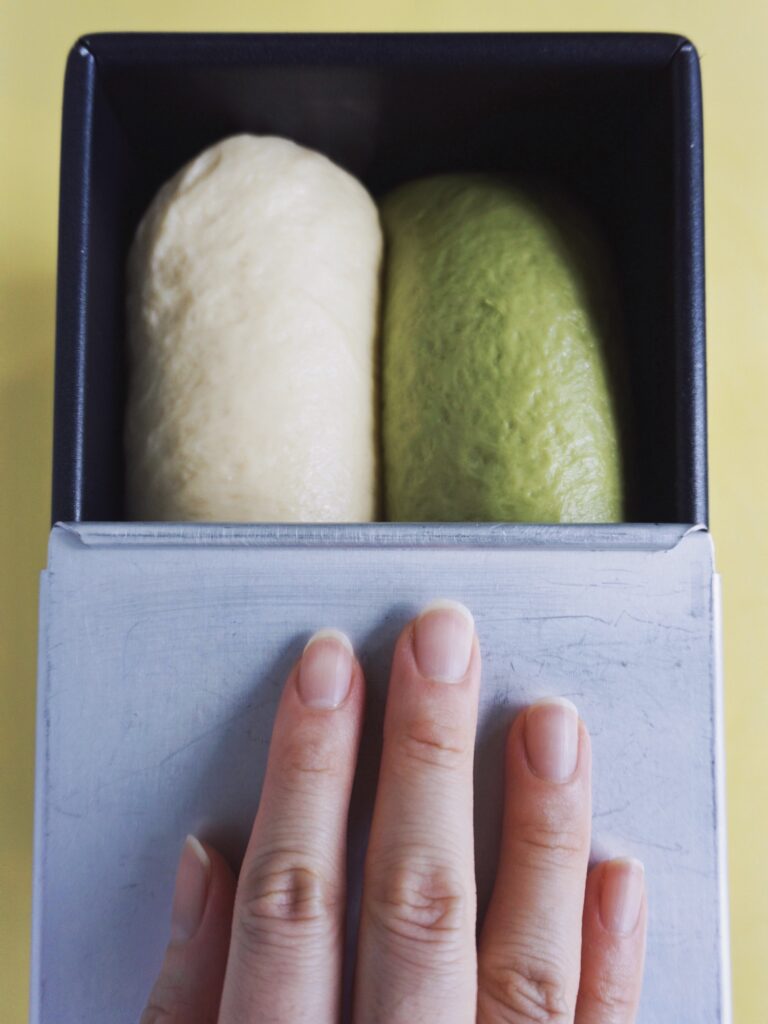
In order to attain its square shape with this checkered design, you’ll need a Pullman loaf pan which comes with a lid. When using the lid to bake the matcha milk bread, it helps the dough grow into the shape.
The recipe shared below is suited for a 450g loaf pan (dimensions are 8x4x4 inches). You could also easily halve the recipe and apply the same shaping method if using a square 250g Pullman tin (4x4x4 inches).
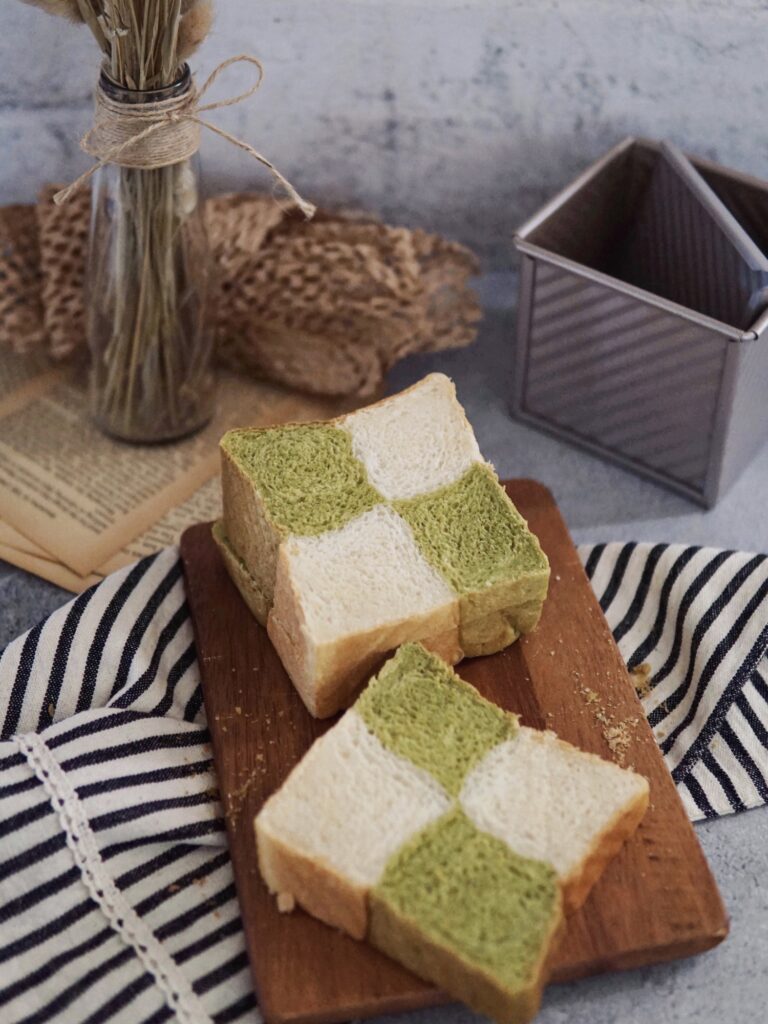
Here is the fun part, after dividing up both dough into equal weighing balls, line them up in alternating colors, two at the bottom, and two on the top. Try to keep equal distances in between so that it proofs evenly. If you need some visual guidance, click HERE for a quick video on how I shaped this Matcha Milk Bread.
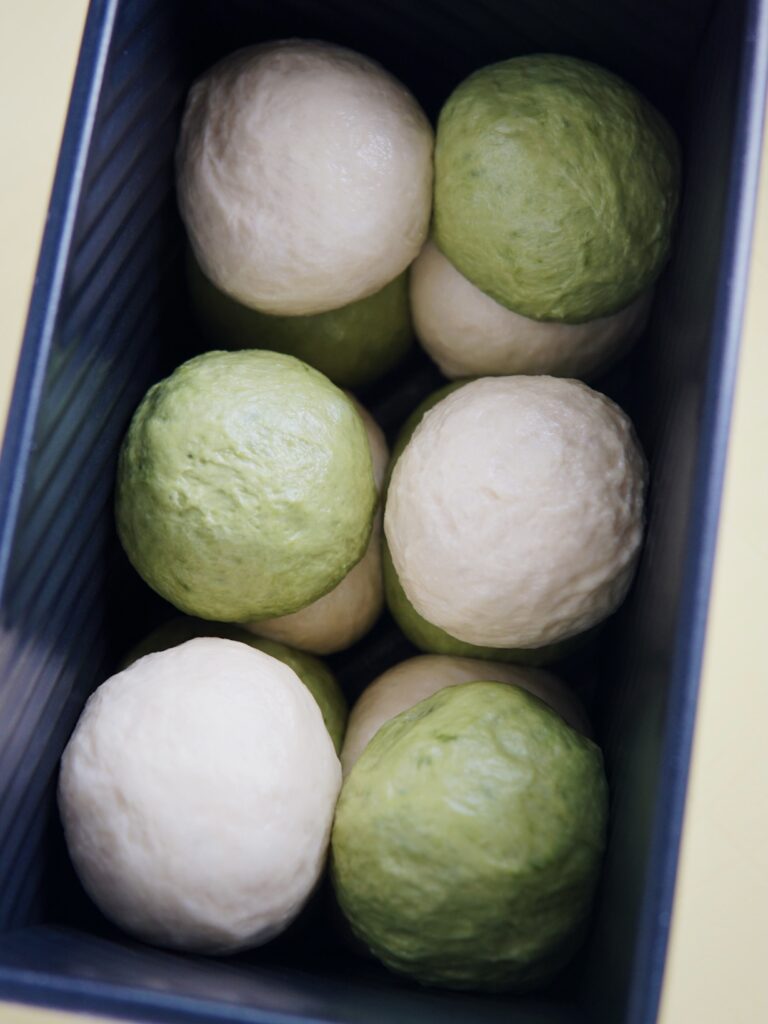
Before Proofing 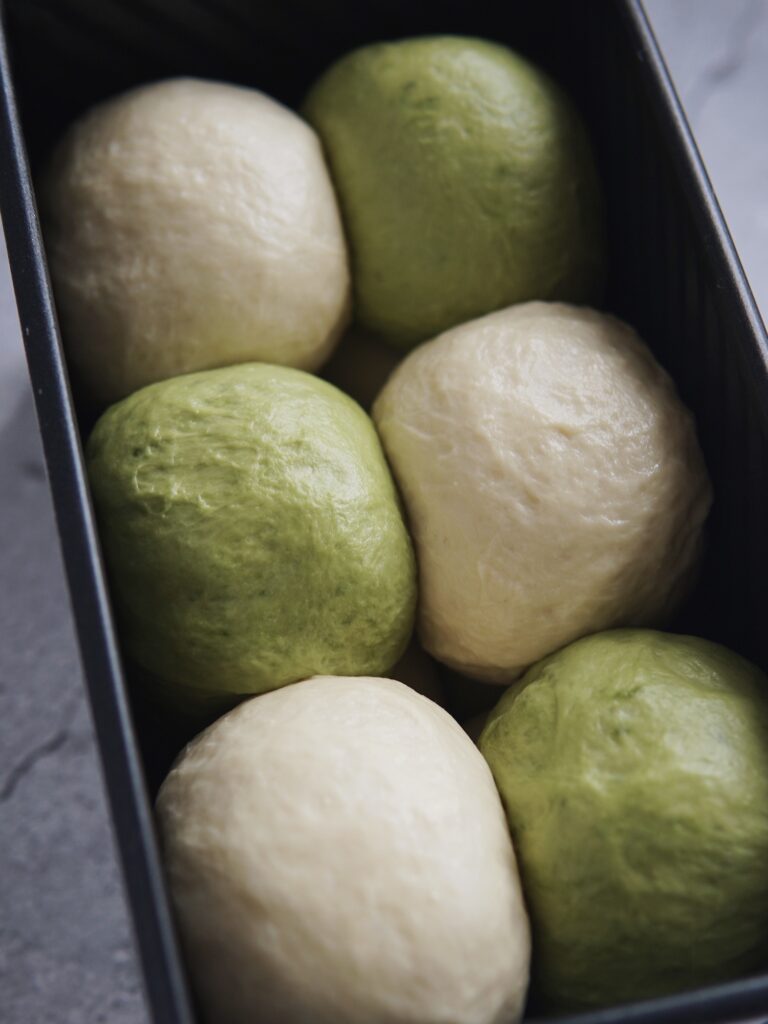
After Proofing
How about some swirly patterns instead for your matcha milk bread?
Alternatively, you could also use the recipe below to make a Swirled Matcha Milk Bread with a twist like the below:
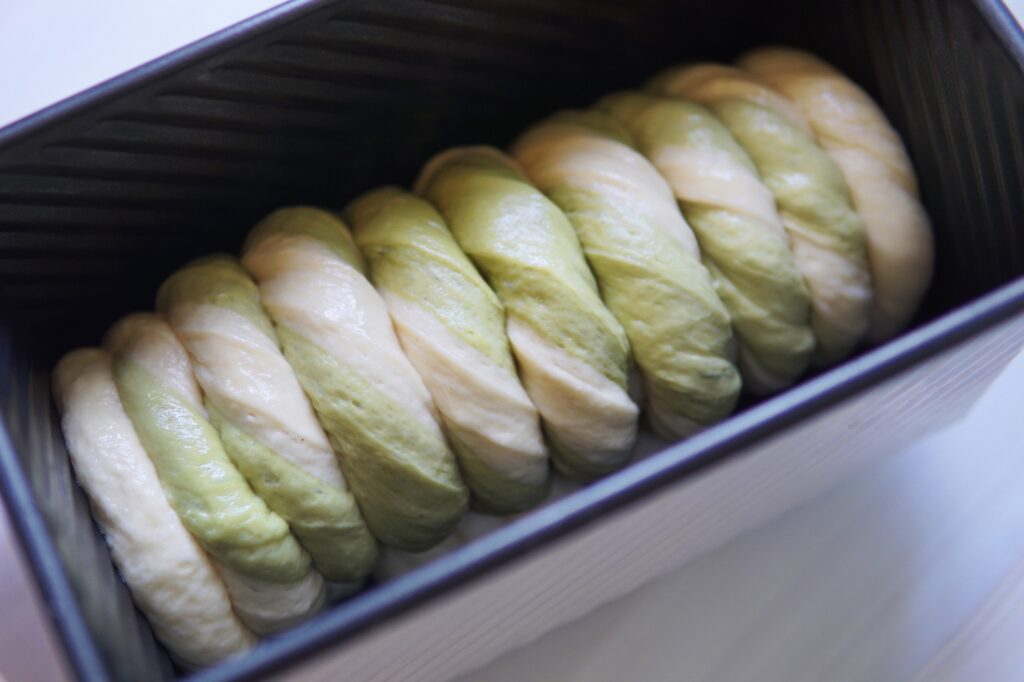
In order to achieve this twisted look, what you’d need to do is to first flatten the milk dough into a long rectangle. You’d then repeat the same for the matcha dough. You’d want to place the matcha dough atop the milk dough, then using a pizza or dough scraper, cut thin strips along the bottom 3/4 of the dough. Twist each strip in the same direction, then start rolling from un-cut portion all the way to the bottom. Remember to place the dough seam side down. You can find the video guide on how to shape it here.
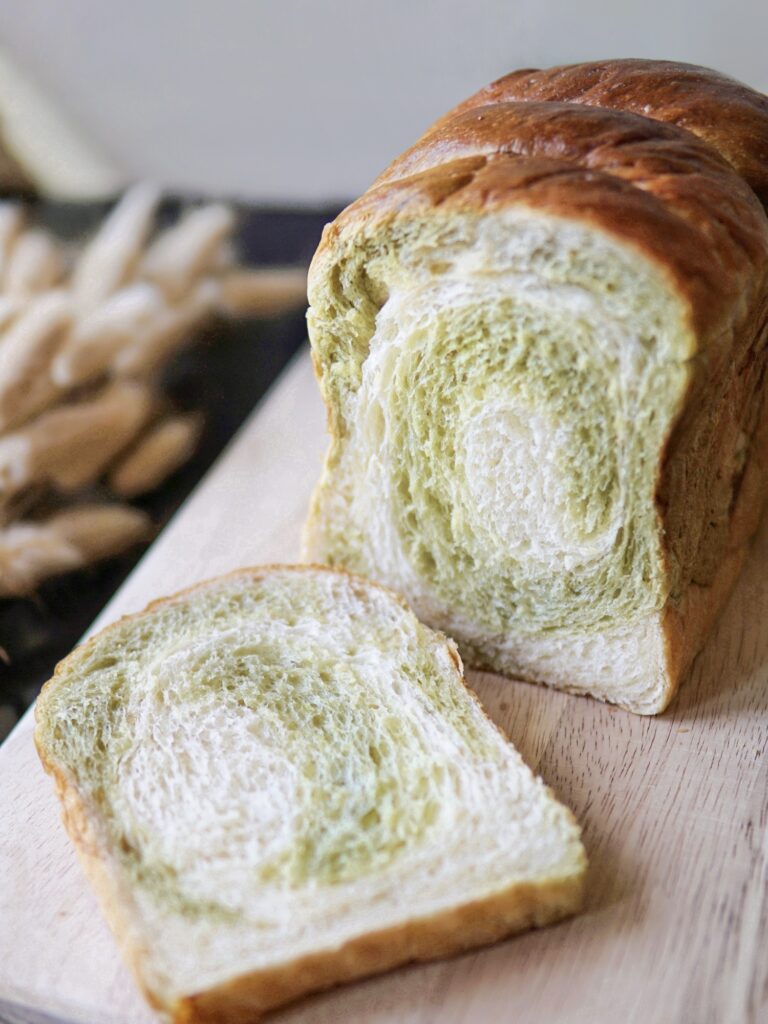
If you cannot get enough of soft, springy milk bread made using the Tangzhong method, be sure to check out these other recipes!
- Tangzhong Milk Bread with various flavour or shaping options noted at bottom of recipe such as: Chocolate Milk with Fruits & Nuts / Earl Grey with Orange Peel and Dark Chocolate / Burger Buns.
- Ube Milk Bread
- Cow Milk Bread
- Milk & Chocolate Buns
- Apple Buns
- Heart Shaped Tuna Buns
Checkered Matcha Milk Loaf
Ingredients
Tangzhong
- 20 g high protein bread flour
- 100 g milk or water
Main Dough
- 130 g fresh milk chilled
- 1 egg yolk
- 30 g castor sugar
- ½ tsp salt
- 10 g milk powder
- 280 g high protein bread flour
- 1 tsp dried instant yeast
- 25 g unsalted butter room temp
- icy cold water or egg wash for wash
Matcha Dough
- 1 tbsp milk
- 2 tsp matcha powder sifted
Instructions
Please note that I have included two methods below for tangzhong making and dough kneading using either (A) conventional bread machine or (B) Thermomix so do take note of the sub-headings.
(A) CONVENTIONAL – Tangzhong & Dough Kneading
- Prepare tangzhong by mixing flour in water and whisk together in a pot, ensuring the mixture is well combined with no lumps. Cook over medium-low heat, stirring consistently to prevent burning and sticking while you cook.
- The mixture will gradually become thicker. Once you notice that some “lines” appear in the mixture for when you stir with the spoon, it’s done. Your tangzhong is ready.
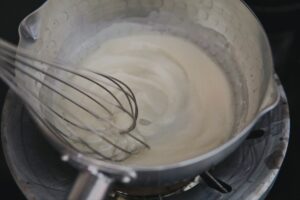
- Transfer into a clean bowl. Cover with a cling wrap sticking onto the surface of tangzhong to prevent it from drying up. Let cool for 15-20 minutes. You can pre-make the tangzhong ahead of time and store it chilled in the fridge for a few days. If you've chilled your tangzhong, ensure to return it at room temperature first before using.
- Whilst tangzhong is cooling, in a small bowl, add 1 tbsp of milk and sift matcha powder into the milk. Stir to combine and dissolve matcha powder completely. Set aside.
- When tangzhong has cooled completely, add all ingredients (except butter) into breadmaker; first the wet ingredients (egg, milk, tangzhong), then followed by the dry ingredients (sugar, salt, flour, milk powder, yeast).
- If using breadmaker, select "dough" mode and let knead until all ingredients come together, usually I let it knead for approximately 8-9 minutes. If using stand mixer, use dough hook to knead until ingredients come together.
- Then add in the butter, continue kneading until the dough is smooth and elastic. The time of kneading in the breadmaker should take approximately 20-25 minutes. For those using stand mixer, upon 20 minutes of total knead time, check to see if dough has achieved windowpane stage.
- Remove dough and transfer to pastry mat. Divide dough into two equal portions. Leave one to rise, and place the other back into mixing bowl. Add matcha mixture from (4) into mixing bowl and knead for 3-4 minutes until well incorporated.
(B) THERMOMIX – Tangzhong & Dough Kneading
- To make the tangzhong, place 20g high protein flour and 100g milk in mixing bowl, cook for 3min/80°C/spd 3 and let stand for 10-15 minutes until temperature lowers down to 37°C.
- Whilst tangzhong is cooling, in a small bowl, add 1 tbsp of milk and sift matcha powder into the milk. Stir to combine and dissolve matcha powder completely. Set aside.
- Add 130g milk, egg yolk, sugar, salt, milk powder, remaining 280g high protein flour and yeast then knead 4min.
- Add butter, knead 1min.
- Remove dough and transfer to pastry mat. Divide dough into two equal portions. Leave one to rise, and place the other back into mixing bowl. Add prepared matcha mixture into mixing bowl into and knead 30 seconds until well incorporated.
Bulk Fermentation & Dough Shaping
- Transfer matcha dough to pastry mat and shape both doughs into smooth, round balls. Let proof in a warm place covered loosely with clingwrap/damp towel until doubled in size (approx. 45-60 minutes).
- Grease hands lightly with neutral flavoured oil or butter, then punch down both milk and charcoal dough to deflate. Divide milk dough into 6 equal portions. To pre-shape, roll each portion into a round, even ball then let sit on bench to rest, covered for 15 minutes.
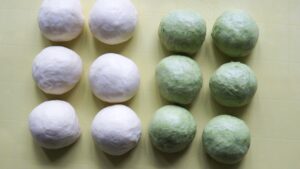
- Shape each portion into tight round balls and place in a greased 450g loaf pan alternately. This means if you are placing a milk dough on the bottom, you will need to place a matcha dough next to it on both sides, and also above it as per example below:
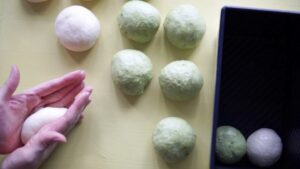
- Let dough rise for its 2nd round of proofing, until double in size. This takes another 35-40 minutes depending on the weather. The best temperature for 2nd round proofing is 38°C, humidity 85%.Note: If you are not in a tropical climate or if it is winter where you are, place a cup of hot water inside the oven, set to 35-38°C and allow your dough to rise inside. Alternatively, you may also heat up a cup of water in the microwave for 60 seconds then proceed to cover dough with a cloth/cling wrap, and let rise inside the microwave.
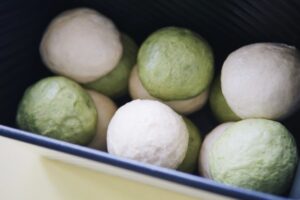
- During last 15 minutes, preheat oven to 190°C.
- As we want to achieve a nicely square-shaped loaf, put on greased lid and bake at 190°C for 25 minutes, then lower down the temperature to 180°C and bake for a further 10 minutes.
Notes
FAQ
Can I use whole egg instead of just the egg yolk?
By using just egg yolks, we are adding fat, richness and flavour to the bread. The fats from the yolk works to tenderise the crumb and lighten the texture which gives our loaf a rich and soft crumb. You can use the whole egg if you like, but you will have to adjust the recipe accordingly or you’d be adding too much hydration with the addition of the egg whites as well.
How do I know if my bread is well proofed and ready to be baked?
You may perform the visual test to check. Lightly press the surface of the proofed dough with the tip of your finger for about 2 seconds and observe how fast the dough bounces back up.
- UNDER-PROOF: If it bounces back up too fast without any indentation, it isn’t ready yet, so give it more time.
- READY TO BAKE: It is supposed to bounce back up slowly, about halfway up and leave a slight indent.
- OVER-PROOFED: If the indent remains without bouncing back up, yes it is over-proofed.
Which oven rack and what oven setting should I use?
I suggest the second rack from bottom. I bake using top and bottom heat, with fan.
When to remove bread from tin?
Upon removing from oven, immediately remove it from the bread tin and let cool on a wire rack. This step is crucial in ensuring there is proper air circulation and that condensation does not happen causing your bread to get wet/soggy at the bottom.
Should I cover the bread as it cools?
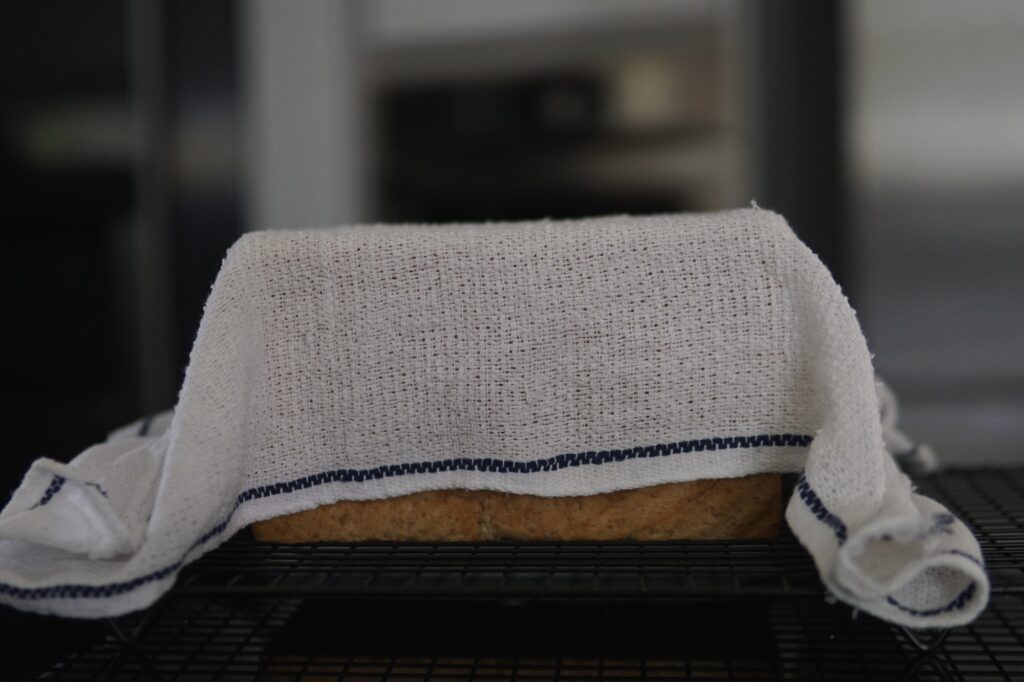
It isn’t necessary to do so. By covering with a cloth, the cloth captures the steam that makes its way outwards and acts to soften the crusts. If you prefer crust with more of a bite, then there’s no need to cover the loaf.
When do I slice the bread?
Of course, I understand how hard it is to resist freshly baked bread. But! Slicing into your loaf of bread before it has cooled down completely may sometimes result in wet gummy crumb texture. Always let your bread rest for at the very minimum 30-60 mins, best for 1.5-2 hours. Just like how you would rest your meat after cooking, the same theory applies for your bread. By allowing your bread to cool completely, it helps stabilise the crumb structure.
Once it has completely cooled down, you may store entire loaf and slice only when you wish to consume. This is because the longer you rest it, the easier it will be to slice the bread. If you’re finding it tricky to slice a loaf of freshly baked bread, check out my video on how I slice soft loaves.
Oh no! My bread caved in at the sides after baking. What should I do?
Unfortunately there is nothing we can do to save a bread that has caved in and collapsed. But you could take note of a couple of things that may have potentially caused this and ensure the same does not happen for your next loaf. The collapsing is a result of the exterior wall being too weak to support the structure. There are two reasons that may have caused this:
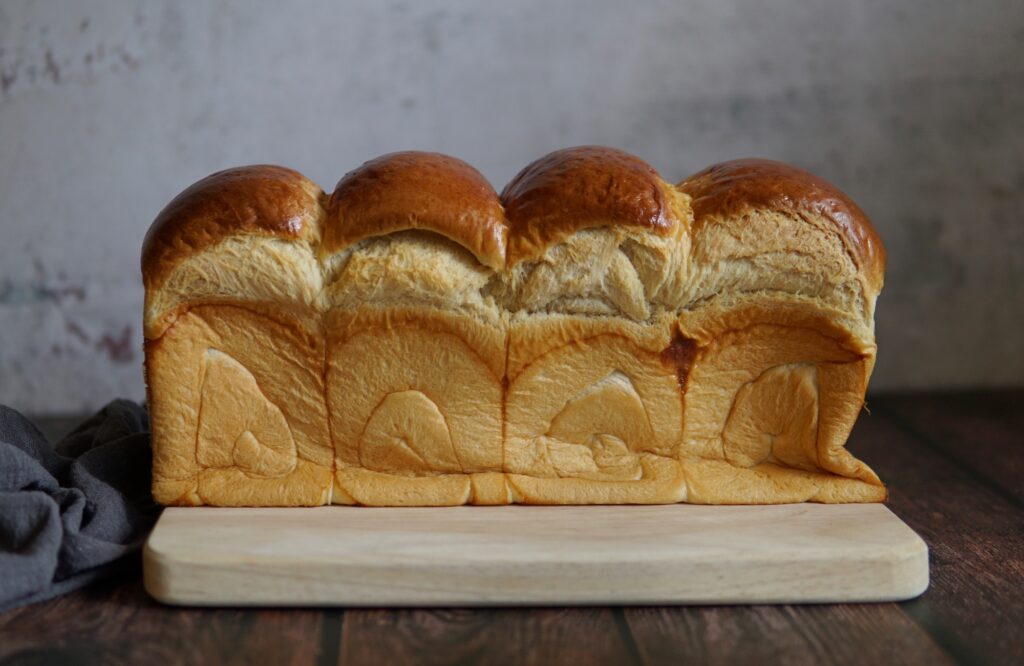
1) Your bread may potentially be under-baked. Try baking it a little longer to set the wall but if it is browning too much, you could tent the top with foil or baking paper. Alternatively try baking it at a higher temperature during the first 1/3 of the baking time then drop the temperature to finish cooking for the remaining 2/3 of baking duration.
2) Sometimes the bread would also cave in if the dough was over-proofed during second proofing as the whole structure is too weak to support the entire tall loaf. I suggest setting a timer less than the duration you intend to let it proof so you have time leeway. Perform the visual test if need be.
How to store bread?
Ensure to store bread in airtight container or ziplock bag so the bread can stay soft and last for up to 2-3 days at room temperature.
What do I do with leftovers that I can’t finish in 2-3 days?
If you are unable to finish within the first 2-3 days, it is best to store your bread in the refrigerator since there is no added preservative. Without preservatives, our homemade bread will not stay as soft and fresh as other commercial loaves beyond 3-4 days. Before consuming though, you may want to either toast/steam/microwave.
Have you tried this recipe?
IF YOU MADE THIS RECIPE, I’D LOVE TO SEE HOW IT WENT!
TAG ME ON INSTAGRAM @THEBAKEANISTA SO I CAN HAVE A LOOK AND RE-POST ON MY IG STORIES!
IF YOU ENJOYED THIS RECIPE, YOU MAY WANT TO CHECK OUT MY RECIPE INDEX FOR OTHER DELICIOUS RECIPES.

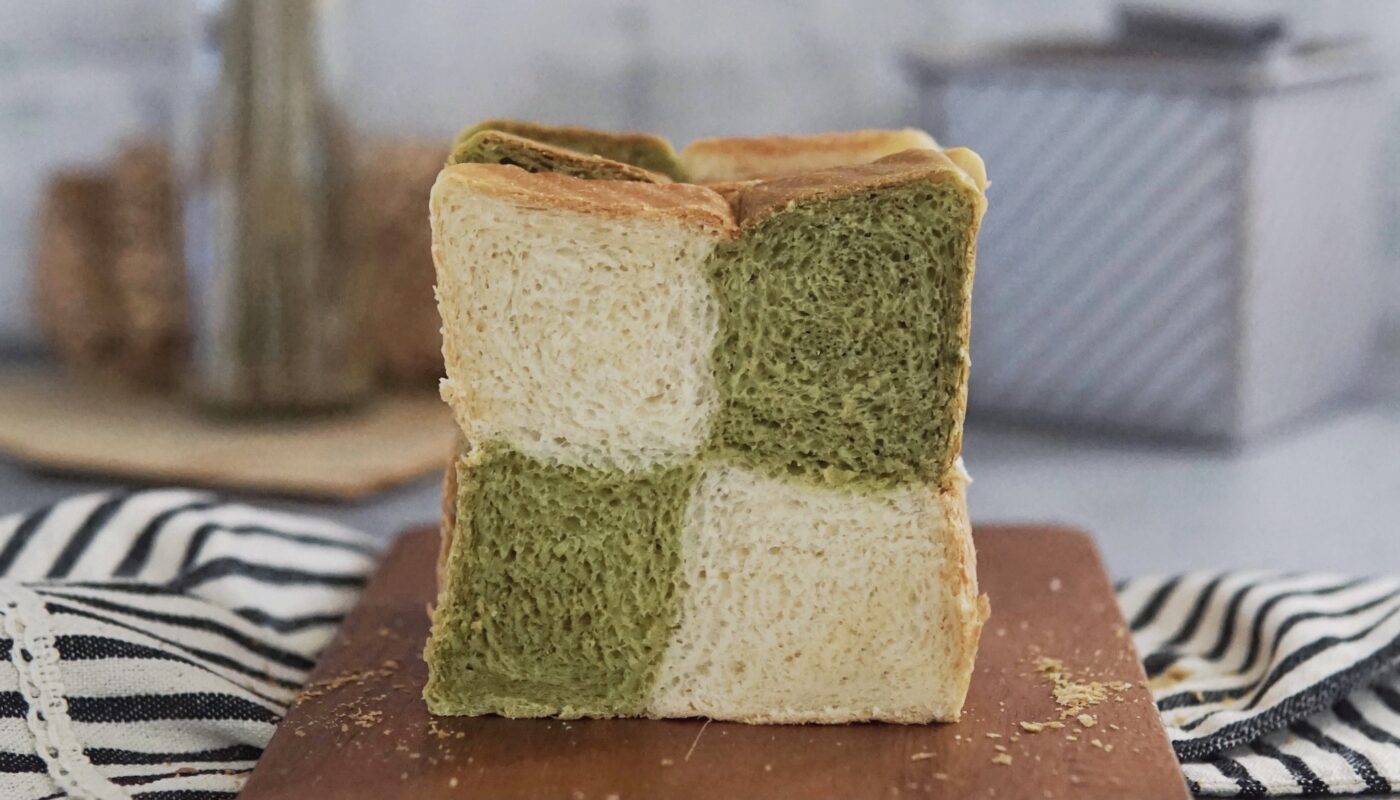
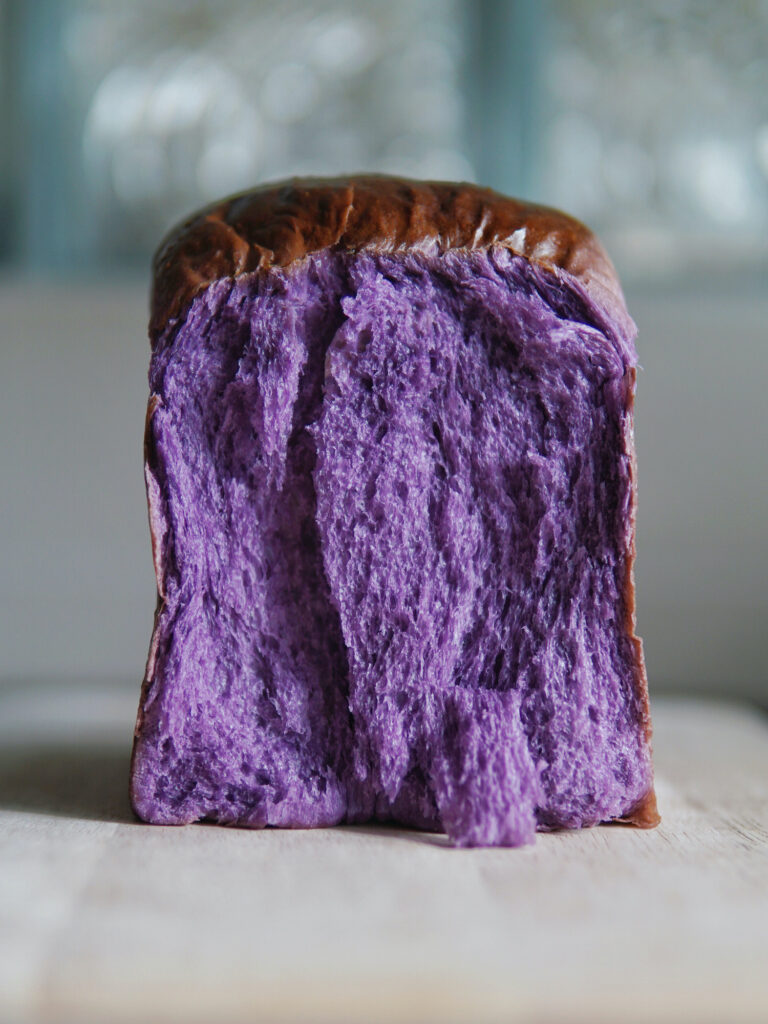
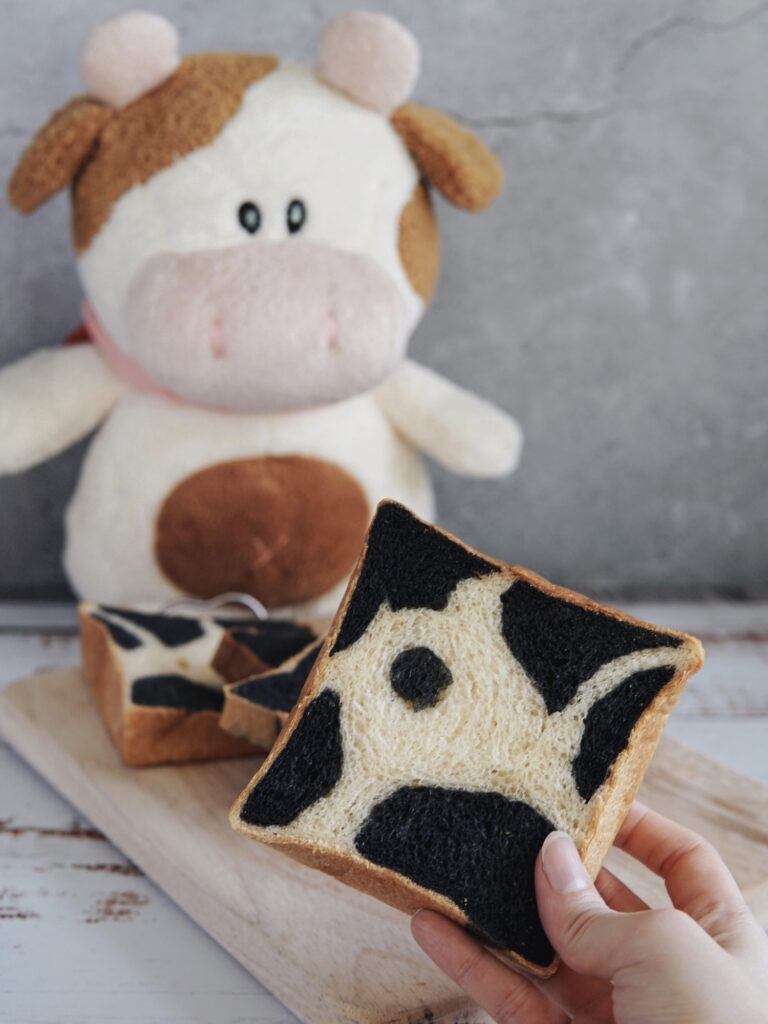
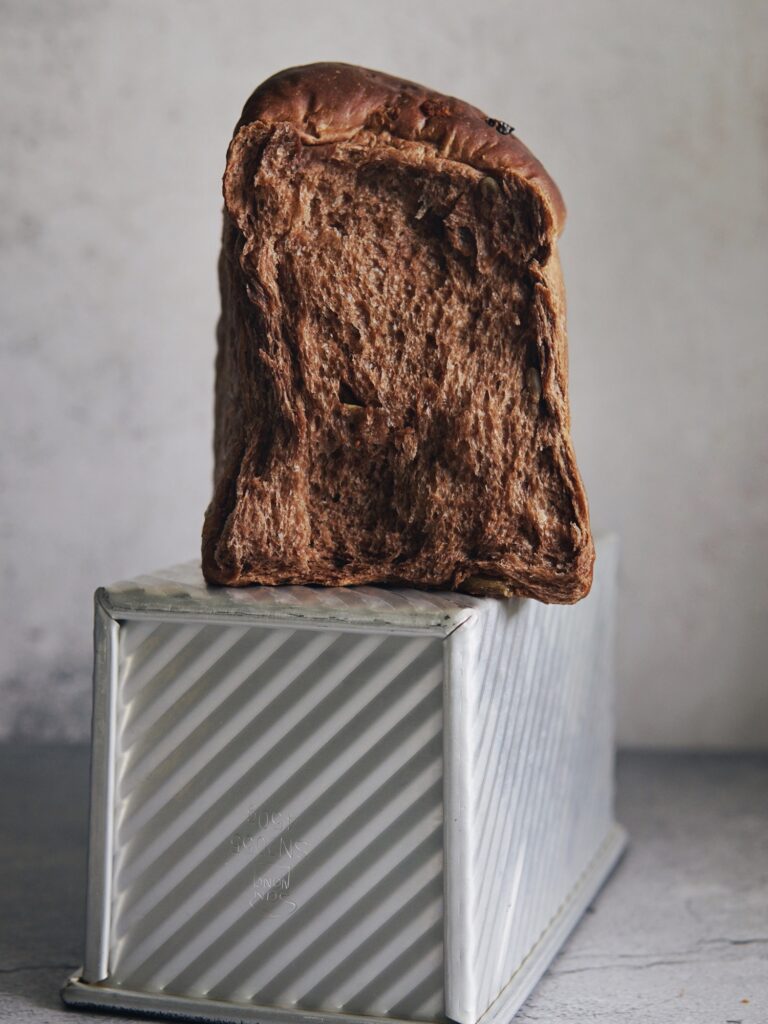
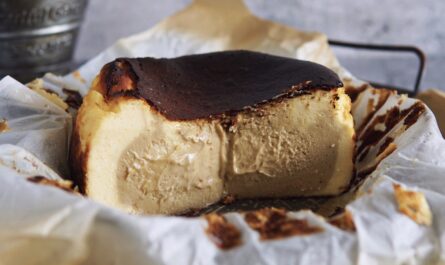
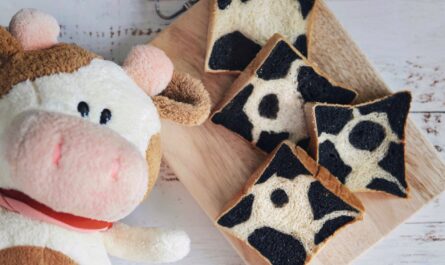
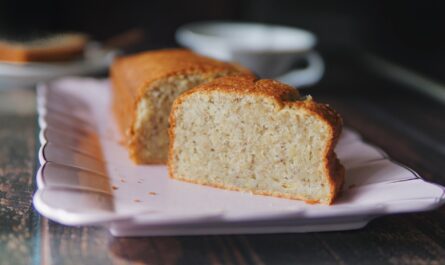
Baked this loaf this morning and it’s so soft, fluffy and pretty! Thanks Michelle for the detailed recipe! 😀
Baked this loaf this morning and omg it’s so soft, fluffy and pretty 😍 Thanks Michelle for the recipe! Gonna make this again and again!
Baked this loaf yesterday and am very pleased with the texture and of coz the shapes! Thanks Michelle for the very clear step to step guide! Love you to the Max!😝
Thank you for the recipe. Love the outcome! Instructions are clear and easy to follow too. Gonna try this in another flavour this weekend! 😊
Woohoo! Look forward to seeing yours too. Please tag me @thebakeanista or share your baked loaf with me over DM. 🙂
Love this recipe and very helpful in giving guidance. response very fast when i message her on instagram.
looking forward to try more recipe from this site.
Glad to hear that Suyin! 🙂
just tried this recipe ysd night and it turned out so beautifully !! love it thank you so much for the recipe !!
just tried this recipe ysd night and it turned out so beautifully !! love it thank you so much for the recipe. cant wait to try more recipes
Hi! So very excited to try your version of this bread. Would you mind linking the pan you used? I have a 9x4x4.
Mine’s a 8x4x4” – but sorry I don’t have a link as I purchased it from the store.